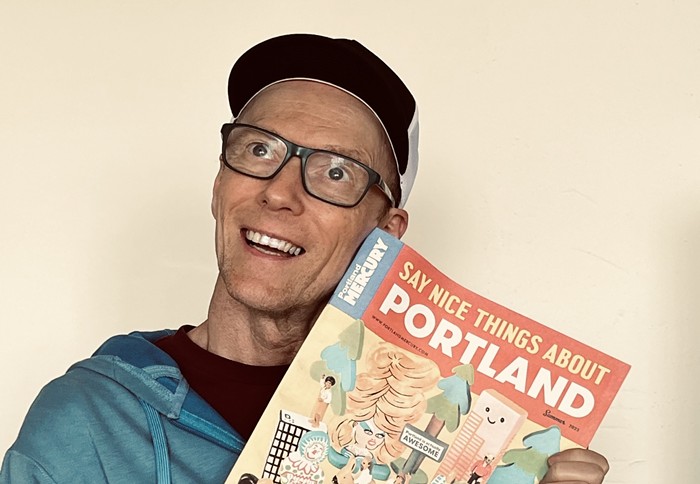IN THE EARLY 1900s, an immensely popular political cartoonist named Homer Davenport drew Theodore Roosevelt being personally endorsed by none other than Uncle Sam. "He's good enough for me," said Sam. The cartoon was immensely popular; as a thank you, the president pulled some political strings to send the cartoonist on a lavish vacation to what is now Syria, where Davenport was able to bring back a stable of Arabian horses.
Earlier this year, Gus Frederick of Liberal University began the Davenport Project, which aims to preserve and re-publish the Oregon-born cartoonist's work. (The project recently completed a successful Kickstarter campaign, and will celebrate Davenport's life in early August at Silverton's Homer Davenport Community Festival.) Davenport, who worked for the Oregonian, the Sunday Mercury (no relation), and eventually William Randolph Hearst, was the Jon Stewart of his day, lampooning political figures and events in the mass media of the time. "He was very famous," says Frederick. "At the time his name was a household word... oftentimes his so-called 'victims' would request the originals of his cartoons."
In 2011, a Syrian cartoonist named Ali Farzat was pulled from his car and beaten for his caricatures of Bashar al-Assad. Through the abuse and the bag on his head, government thugs commanded Farzat to stop drawing the president. Farzat survived the beating and continues to work.
In the America of the 1890s, political cartoons propelled Davenport to success and celebrity. In contemporary Syria, they inflamed the rage of a dictatorial regime. They inflame no such passions in the contemporary US, though. Political cartoons are largely a lost art.
"The [number of] people who can make a claim to being a full-time political cartoonist is less than 60," says local political cartoonist Matt Bors. "Papers are dumping them. Most of the guys who are lucky enough to have jobs are at least in their 40s. Most papers aren't going to replace them." At 28, Bors is younger than the vast majority of political and editorial cartoonists working today. He is also (relatively) successful. Bors has been a Pulitzer Prize finalist, he won the prestigious Herblock Prize, and he estimates that in May of 2011 his website got over 800,000 page views and a quarter million unique impressions. Despite his success, though, Bors has not been able to secure a regular position with a publication or website.
"The majority of my income is not from the thing I'm actually known for," he says. "I've always kind of been happy with the idea of being a freelancer... and I'm content with that," he says, "but actually, lately, I've been wondering, 'Why don't I deserve a job?' I think the actual numbers that I get on my website are larger than the kind writers get who are able to justify salaries at websites."
Oregonian cartoonist Jack Ohman is one of the lucky few cartoonists who maintains a full-time position. Ohman does not disguise his annoyance with the direction that the field has taken, naming off a litany of cartoonists who have been cut or forced into retirement.
I ask Ohman about how many full-time American cartoonists there still are. "We think around 55," he says, "full time, daily, dental plan. In the 1980s, it might have been as high as 220. Every major newspaper had a cartoonist on staff. Now, it's just really grim." Websites are no better. According to Bors, "There are only really two people who can make a claim to working at a website. Dave Horsey at the LA Times and Matt Wuerker at Politico."
The much-ballyhooed decline of print media has definitely contributed to the plight of the American political cartoonist, but that hardly accounts for the entirety of the art's decline. Ohman and Bors are, in some ways, very different cartoonists. Bors is young, read online, and published in alternative weeklies (like the Mercury), whereas Ohman has been cartooning for over 30 years, works for a traditional newspaper, and is syndicated. They both agree on an important point, though: American political cartooning has not changed with the times, and in some ways has not stayed artistically or culturally relevant.
"I find mainstream political cartooning kind of banal," says Bors. "It's a kind of bizarre lingo that doesn't work for people under 40." Bors is restrained and polite, simply explaining that he doesn't like cartoons that employ clunky, ham-fisted metaphors. (Think a sinking ship labeled "the economy.") The veteran Ohman, though, is far more vocal in his criticism.
"I've had several really long conversations with people like [cartoonist] Ted Rall over the years," says Ohman, "saying things like, 'Just wait, your style is going to come in and it's all going to change and all those Uncle Sam elephant/donkey cartoons are going to go out the window.' It hasn't changed."
There are people who are getting rewarded, who have Pulitzer Prizes, who are dreadful hacks. They're horrible. And they know it. And they're despised by people in the profession. I'm not using any names. They know who they are."
In the late '90s, Ohman attempted to branch out in the world of syndicated newspaper strips with a comic called Mixed Media. The strip was about (obviously) the media and media culture, and Ohman attempted to inject a bit of editorial-page satire onto the comics page. During his time with the strip, Ohman learned just how dusty and conservative the newspaper comics page had become.
"People under 18 were responding to my comic strip and people over 60 weren't responding to my comic strip. I could see the surveys. The older the demo skewed, the worse I did. They were more into Blondie and Beetle Bailey. My dad was in his 60s when I was doing Mixed Media. I said, 'Good news, Dad! The syndicate sales rep was going through Colorado and we knocked out Beetle Bailey in four newspapers.' I was obsessed about Beetle Bailey. Hated Beetle Bailey. It's sexist, it's stupid, it's out of date. My dad said, 'That's my favorite comic strip.' I'm constantly amazed by what people will tell me their favorite comic strip is."
Beetle Bailey still runs in newspapers everywhere. Mixed Media does not. "You go and look at comics in alternative papers and they're just stunning," says Ohman. "The bad ones are good. They're more relevant, they're more interesting, and they can go further." Whereas in the mainstream press, "You can have somebody as brilliant as [Matt] Bors who's going to do a four-panel cartoon and then the Fresno Bee or whatever is going to take a look at that cartoon and say, 'I don't have the space. Nobody's going to be able to read this.' Frequently the editors [picking cartoons for the editorial section] are not artists, and frequently they aren't even editorial writers, they're copy editors. They'll say, 'Okay, this is a clean drawing for me. It's accessible. It's not busy.' Editors are very fussy about that. You've got to give them something that's object, figure, balloon. And don't put more than 20 words in the balloon."
In mainstream newspapers, cartoons are an afterthought. The cluttered, compressed pages offer little space for any kind of image-based commentary to breathe. That doesn't mean the public doesn't want it. "Memes," says Bors, referring to image macros and the like, "have replaced political cartoons in some way." Demand is there. The talent who devote themselves to that particular art, though, can't turn it into a living. A century ago, Homer Davenport's skills made him a celebrity. Now, Ohman watches his associates dwindle, and Bors has been unable to turn his awards and acclaim into a full-time job.
"There's nobody coming up behind us," says Ohman, who still believes in the power of images. "In kind of my crazy post-apocalyptic reverie," he says, "I have an idea for a website. I could get you all the best cartoonists in America. All I need is $40 million."














